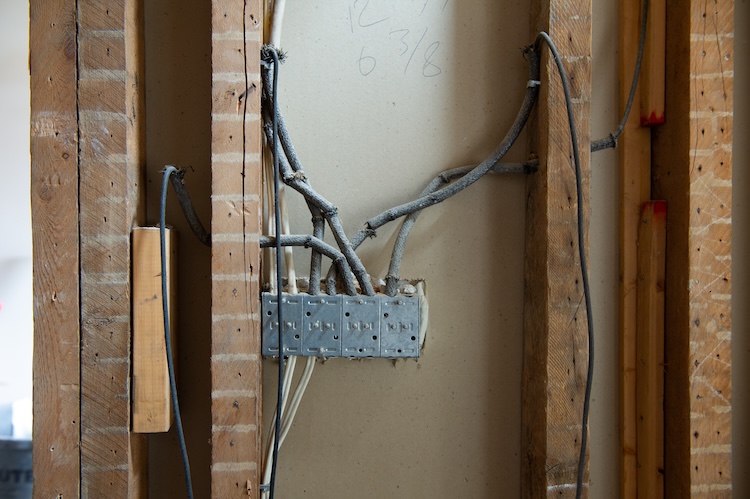Becoming the owner of an older, heritage-style home, can be thrilling, but also incredibly challenging. If your house was built prior to 1950, you’ll need to consider the type of wiring the home has, for instance, copper, aluminum, or knob and tube (k&t). If it is an older house, and it has never been completely rewired, it could have knob and tube wiring. If this is the case, it’s quite likely you’ll have a problem when you begin shopping around to get house insurance.
Just because the home has k&t wiring, it doesn’t mean the house is in imminent danger of burning down. If the wiring has been well maintained and hasn’t been used as a clothesline in the basement, it may be just fine.
What is knob and tube wiring?
You won’t see any k&t wiring in newer homes, but if your home was built in 1950 or earlier, take a look in the basement. If you notice wires running through porcelain cylinders or “tubes” inserted in holes in the wooden floor joists, you have knob and tube wiring. You’ll also see porcelain “knobs,” which keep the wires secure, and prevent them from touching the wood along which the wires run. The wires are usually insulated with a rubberized cloth fabric.
One of the main differences between modern wiring and the old knob and tube is that there is no ground wire. Therefore, this type of wiring cannot accommodate any electrical items with three-pronged plugs, and the risk of shocks and fire is much greater. Also, the black and the white wires run separately, while in more modern wiring, you will see that the black wire, the white wire, as well as the ground wire, are all enclosed in a single cable. Another difference is the wire insulation. Modern wiring is insulated with plastic, while knob-and-tube uses rubber. The breakdown of the insulation over time on knob-and-tube wiring is often the reason it is replaced. It’s important to note that this is frequently the result of overheating or mechanical abuse.
You may have found it difficult to obtain home insurance if your home has k&t wiring. In fact, this type of wiring is not inherently dangerous. Problems arise when the insulation around the wires begins to deteriorate with age, or when home handymen have made alterations to the wiring. Knob and tube wiring should never run through insulation, especially blown-in insulation, as this type of wiring requires open space to keep cool. Any insulation surrounding the wiring can cause serious problems. In fact, this wiring is sometimes referred to as “open wiring” which helps to emphasize the importance of maintaining open airspace around the wire at all times to prevent any overheating.
There is nothing in the building code in America that states that k&t wiring must be removed from existing homes, but it is considered obsolete, and can’t be used in any new construction.
What can go wrong with knob and tube wiring?
Any of the problems listed below can cause short circuits or overheating. To avoid these problems, you may need to replace your house’s wiring. If in doubt, have an electrical inspection done.
- Insulation over the wiring: If household insulation is installed over knob and tube wiring, a fire is just waiting to break out. The wiring is coated with a rubber/cloth insulation. It needs lots of space to dissipate the heat that builds up when an electrical current is flowing through. If there’s no room, because it’s been covered with insulation, a very dangerous situation is created.
- Excess use: Knob and tube wiring was installed when there were really very few electrical appliances in the average home. Nowadays, with TVs, sound systems, computers, washers, and dryers, the system can easily become overheated. Many times, there is overuse of extension cords, and power bars, as well. Old systems are just not designed to handle the demands for electricity that occur in our modern computerized world. The ground pin (or third prong) on power bars or other electrical items should never be removed to accommodate the two-pin outlets used in k&t wiring.
- Alterations: Most problems occur with k&t wiring as a result of improper alterations being made to the existing wiring. As it’s such an old system, proper replacement parts are not always available, which could be the reason a lot of makeshift handyman fixes are so dangerous. Knob and tube wiring is easily accessed in the basement, which is perhaps the reason why this wiring is often spliced unsafely with modern wiring by home handymen, as opposed to certified electricians.
- Damage: Serious problems can occur when this type of wiring is damaged, either due to wear and tear, handyman fixes, or other types of damage. Porcelain knobs and tubes can crack, and the wires tend to sag and fray over time exposing live wires.
- Brittle insulation: The rubberized cloth insulation on k&t wiring becomes brittle over time and can flake off.
Plugging in a lamp, or even a TV, in your living room or bedroom really doesn’t pose much of a risk when you have k&t wiring. However, in places where there’s a possibility of contact with water, for instance, the bathroom or kitchen, this type of ungrounded system could be extremely dangerous.
What can you do to maintain your knob and tube wiring?
If you currently have k&t wiring in your home, the International Association of Certified Home Inspectors (InterNACHI) provides the following advice:
- Have the system evaluated by a qualified electrician. Only an expert can confirm that the system was installed and modified correctly.
- Do not run an excessive amount of appliances in the home, as this can cause a fire.
- Replace all outlets with ground fault circuit interrupter (GFCI) outlets. These are three-prong outlets with a built-in reset button.
- Where the wiring is brittle or cracked, it should be replaced. Proper maintenance is crucial.
- K&T wiring should not be used in kitchens, bathrooms, laundry rooms, or outdoors. Wiring must be grounded in order to be used safely in these locations.
- Rewiring a house can take weeks and cost thousands of dollars, but unsafe wiring can cause fires, complicate estate transactions, and make insurers skittish.
- Homeowners should carefully consider their options before deciding whether to purchase a home with k&t wiring.
- Prospective home buyers should get an estimate of the cost of replacing k&t wiring. They can use this amount to negotiate a cheaper price for the house.
What is the life expectancy of knob and tube wiring?
Copper wiring can last up to 100 years. Knob and tube can last a long time, too, but one of the main problems with k&t wiring, of all the ones listed above, is the problem with old, worn, insulation. This tends to become brittle, and can easily break off, leaving bare wires exposed. Experts recommend you replace the wiring with new updated copper grounded wiring.
The replacement cost of a home’s entire system with copper wiring really varies depending on the size of the home and the amount of k&t wiring in place. But it is not outrageously expensive and can be done fairly quickly, and with very minimal damage. The end result will be a more efficient, safer home, and will also increase the resale value should the time come when you decide to sell.
What will your home insurance company want to know?
Your insurance company will always want to know what type of wiring your home has. They’ll want to know if the entire house has been wired this way, or if some of the home has been updated. They may require you to have an electrician inspect the wiring before they can offer you home insurance. A number of problems can occur when only part of the house has been rewired, and the rest of the home still has knob and tube. The connections between the two systems may expand and contract at different rates, causing connections to become loose.
Also, knob and tube wiring runs on a 60-amp service, but most insurance companies will require your home to have a 100 amp service/breaker panel.
There are companies that will refuse to insure you with k&t wiring, as they consider the risk to be too high. However, there are others that will insure your home, perhaps with a higher premium or higher deductibles. There may also be a requirement to have an electrical inspection done by a professional before coverage can be offered.
Buying a beautiful older home has its benefits as well as its challenges. Having to cope with knob and tube wiring is definitely one of the biggest challenges you’ll face. You may find that providers won’t insure you at all, or they’ll insure you but at a higher premium.
Other Commonly Asked Questions
Can knob and tube wiring be grounded?
If the electrical outlets in your home have three prongs, it’s safe to say that the wiring connected to it has been appropriately grounded. Knob and tube wiring does not feature a third plug-in located just below the other two and thus does not adequately protect from electrical shock if a wire comes loose.
If you’re trying to figure out what type of wiring your property has overall, however, simply checking your outlets for two or three plugs will not be enough. Since other electrical systems, such as sheathed duplex electrical wiring, also use two-pronged outlets, you’ll need to be more in-depth with your research before coming to a final diagnosis.
Unfortunately, if you’re hoping to ground an existing k&t system you will be sorely disappointed. In the interest of staying up to code—not to mention ensuring your home is properly, and safely, wired top-to-bottom—you’ll have to rewire the whole property.
What is the cost of replacing knob and tube wiring?
The exact price of rewiring your house can change dramatically depending on size, overall conditions, age of the property, access to wiring, and other factors that are impossible to predict without a firsthand look. So, it’s best to consult with a licensed electrician to get an accurate estimation of what you can expect by the project’s end.
How can you tell if a house has knob and tube wiring?
If you’re not sure whether or not your house uses k&t wiring, it’s worth taking some time to do a brief inspection of the property to find out. The easiest method will involve checking key areas, such as exposed joints in the basement or attic, for any white ceramic knobs nailed to the joists with electrical wiring twisting through them. Barring any unpredictable circumstances, the presence of these telltale signs will almost certainly mean that your house was wired using the k&t method.
It’s worth pointing out, too, that you may still have k&t wiring in your home even if you don’t find any of these indications. In these cases, you’ll want to plan a complete diagnostic to be absolutely certain of what wiring your home uses. In the end, you’ll feel safe, secure, and more knowledgeable of your home overall—and both you and the property will be better off for it.




















































